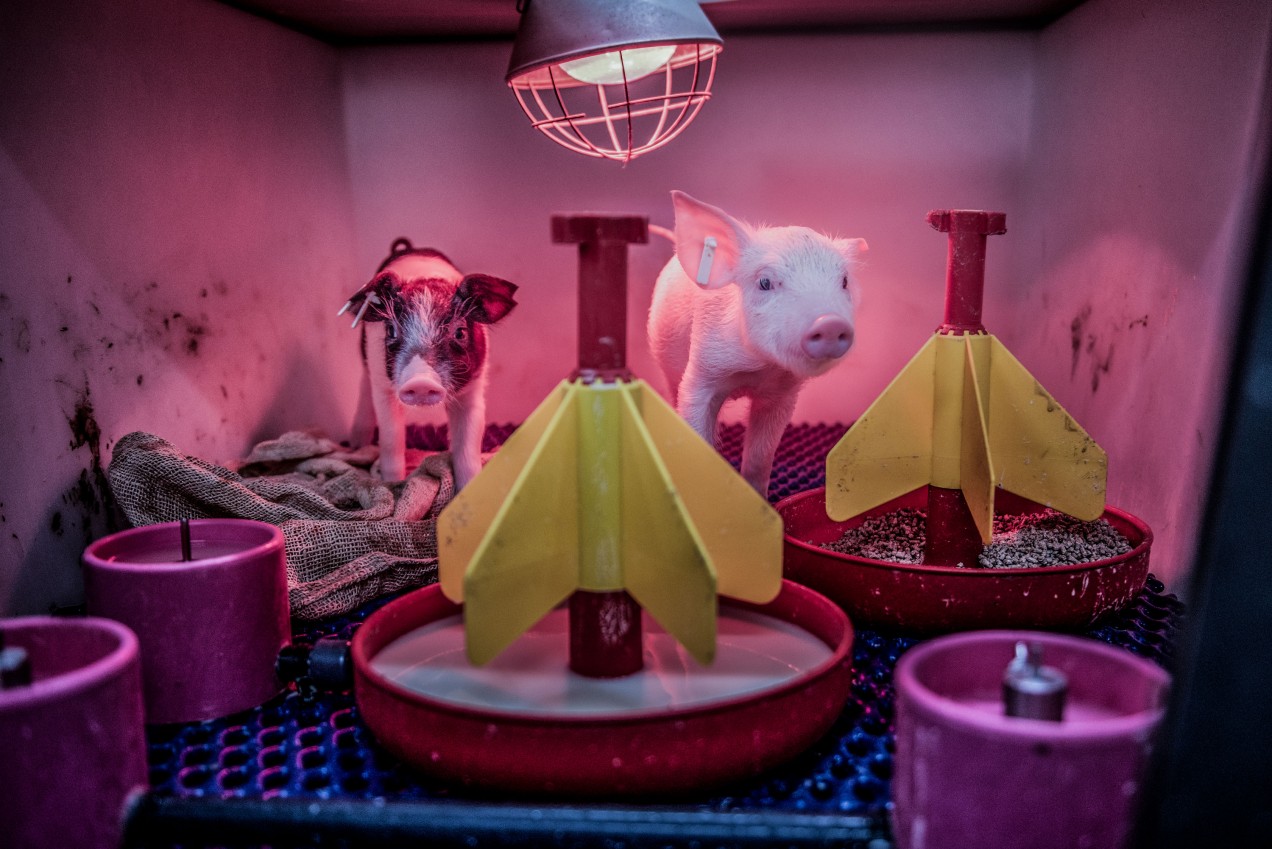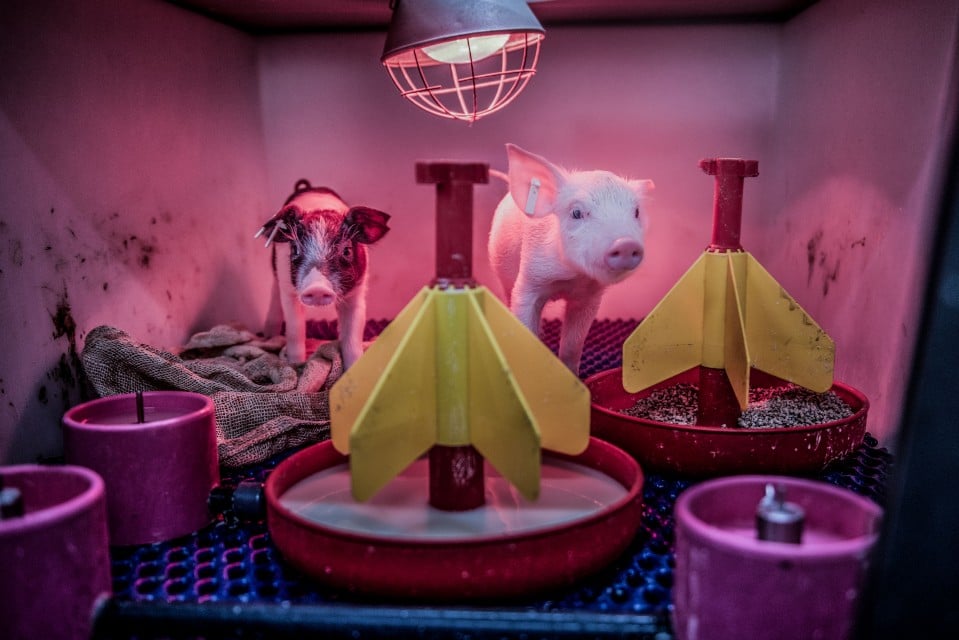

Biotechnology
Meet the pigs that could solve the human organ transplant crisis
On a farm in Bavaria, German researchers are using gene editing to create pigs that could provide organs to save thousands of lives.

The facility lies midway between Munich’s city center and its international airport, roughly 23 miles to the north. From the outside, it still looks like the state-run farm it once was, but peer through the windows of the old farmhouse and you’ll see rooms stuffed with cutting-edge laboratory equipment.
In a newer building at the back of the farm, Barbara Kessler pulls off her sneakers and sprays her bare feet and hands with antiseptic. The wiry veterinarian steps over a taped line in the shower room, leaving behind everything she can from the outside world: clothes, watch, earrings. She scrubs her body and hair—a buzz cut, so it’s easier to manage these frequent washings.
After the shower, she finds her size among the neat stacks of supplied clothes and pulls on a pair of black pants, a red shirt, and black Crocs. Outside the dressing room, she adds a black knit cap to keep even her short-cropped hair from passing on germs, and then strides down the hall to the boot room, where she carefully steps into knee-high rubber boots that are power-washed after each wearing.
All these precautions are to protect animals not known for their cleanliness: pigs. And once Kessler opens the door to the indoor pens, the smell is unmistakable. It’s a pigsty, after all.
When Kessler unlocks one pen to show off its resident, a young sow wanders out and starts exploring. Like other pigs here, the sow is left nameless, so her caregivers won’t get too attached. She has to be coaxed back behind a metal gate. To the untrained eye, she acts and looks like pretty much any other pig, but smaller.
It’s what’s inside this animal that matters. Her body has been made a little less pig-like, with four genetic modifications that make her organs more likely to be accepted when transplanted into a human. If all goes according to plan, the heart busily pumping inside a pig like this might one day beat instead inside a person.
Different types of tissues from genetically engineered pigs are already being tested in humans. In China, researchers have transplanted insulin-producing pancreatic islet cells from gene-edited pigs into people with diabetes. A team in South Korea says it’s ready to try transplanting pig corneas into people, once it gets government approval. And at Massachusetts General Hospital, researchers announced in October that they had used gene-edited pig skin as a temporary wound covering for a person with severe burns. The skin patch, they say, worked as effectively as human skin, which is much harder to obtain.
But when it comes to life-or-death organs, like hearts and livers, transplant surgeons still must rely on human parts. One day, the dream goes, genetically modified pigs like this sow will be sliced open, their hearts, kidneys, lungs and livers sped to transplant centers to save desperately sick patients from death.
The death of Baby Fae
Today in the United States, 7,300 people die each year because they can’t find an organ donor—two-thirds of them for want of a kidney. In many cases, the only hope is someone else’s tragedy: an accident that kills someone whose organs can be harvested.
Surgeons looking for another source of organs at first looked to monkeys, because they’re the animals most similar to us. In 1984, a little girl known as Baby Fae received a baboon heart but died 20 days later, after her immune system attacked it. Baby Fae’s short life and quick death received global attention; many condemned the idea of killing our closest animal relatives to save ourselves. An opinion piece by a cardiologist in the Washington Post described the procedure as “medical adventurism.” Another, in the Journal of Medical Ethics, was headlined “Baby Fae: A beastly business.”
Then, in the 1990s, researchers and biotech companies turned to pigs as the donor of choice. Since we eat pigs (120 million of them a year in the US alone), taking their organs seemed less morally fraught to many. Scientifically, their organs are roughly the right size, with similar anatomy, and pigs reach adulthood in about six months—much faster than primates. But a problem arose: pigs harbor viruses that might make the jump to people. What’s more, with the simple genetic engineering available at the time, the transplanted organs didn’t last long when they were tested in monkeys. They were simply, genetically speaking, too foreign.
When it comes to life-or-death organs, like hearts and livers, transplant surgeons still must rely on human parts.
More than two decades later, advances in genetic engineering have revived the prospect of so-called xenotransplants. The hottest source of debate in the field: exactly how many gene edits are needed in pigs like these to overcome the species barrier. A well-funded US company, eGenesis, which leads the more-is-better-camp, says it has made a “double-digit” number of changes to the pigs it raises with a sister company in China.
The Germans at the Munich facility are in the less-is-more camp. The pigs they work with have three key genetic modifications originally made more than a decade ago—all designed to keep baboons and humans from rejecting their organs. Knocking out a gene that produces a sugar called galactosyltransferase prevented the recipient’s immune system from immediately rejecting an organ from a different species. The second change added a gene expressing human CD46, a protein that helps the immune system attack foreign invaders without overreacting and causing autoimmune disease; the third introduced a gene for a protein called thrombomodulin, which prevents the blood clots that would otherwise destroy the transplanted organ.
A smaller number of edits can be better controlled and measured, and their effects are easier to document, says Eckhard Wolf, who runs this former state farm on the outskirts of Munich, now called the Center for Innovative Medical Models. If something goes wrong, as often happens in xenotransplantation, it will be clear where the issue lies. With more edits come more potential problems. “At some point, you are in a situation that you have no idea what an additional genetic modification does,” he says.
The size of a heart
In 2018, the hearts of pigs from the Munich center were transplanted into 14 baboons. Two of the monkeys survived for six months, the longest any animal has lived with a heart from another species. In a report in Nature last December, the German researchers described their achievement as “a milestone on the way to clinical cardiac xenotransplantation.”
Of the first five baboons to get a pig heart, four died within a day or two, and when the fifth died after a month, its heart was diseased. In the next batch of baboons, Wolf’s collaborator Bruno Reichart, a retired heart transplant surgeon, flooded the organ with nutrients, hormones, and red blood cells from the time it was removed from the pig until it was fully functional in the recipient animal. Three baboons treated with this approach lived for 18, 27, and 40 days.
The last five baboons had the same procedure but were also kept on an immunosuppressant drug. Two lived for 182 and 195 days, but they had to be euthanized last year when still in good health, because it was so challenging to continue the anti-rejection therapy. It isn’t practical to leave an intravenous line in a baboon for longer than six months. But neither is it a simple thing to convince a baboon to take drugs. Like young children, they resist drinking anything that smells like medication.
Reichart says he is working on a better delivery system that will enable the baboons to stay on the anti-rejection drugs for at least a year—the amount of time he says is needed to prove that xenotransplantation is ready to be tested in people.
Midway through their baboon study, however, Wolf and Reichart noticed an unanticipated problem: the hearts, harvested from juvenile pigs to make sure they were small enough for baboons, kept on growing as if they were still destined to keep alive a 600-pound (270-kilogram) pig. The transplanted heart weighed 62% more than a typical baboon heart: “massive cardiac overgrowth,” as their paper described it. In the baboons, the new hearts crowded out other essential organs and, in a few cases, caused the animal’s death.
At the pig facility, Kessler showed me Wolf’s solution to this problem: two sister sows, created with one more CRISPR gene edit. Researchers have turned off the animals’ growth hormone receptor (GHR) gene, leaving them roughly half the weight of a typical pig. Both tip the scales at about 175 pounds (79 kg), compared with nearly 400 pounds for a normal sow. The pregnant sister stood across the hall, alone in a pen facing the wall. Metal bars kept her from lying down against the walls—a precaution to protect the piglet litter. Though she was bred with a full-sized male pig, roughly half of her offspring should be missing their GHR gene.
The cost of saving a life
It isn’t cheap to create a gene-edited pig and then raise it to the standard required by the US Food and Drug Administration and other agencies that would regulate pig-to-human transplants around the world. Kessler and her colleagues clone pig embryos by putting the desired genetic material into eggs collected Mondays and Tuesdays from a local slaughterhouse. To minimize germs, every new line of pigs must start by conceiving the animal in a lab dish, delivering it by Caesarean section, and separating it from its mother at birth. Later germ-free generations don’t require as many precautions and cost only about 10 times the price of raising a pig for bacon and pork, Kessler says.
About 120 gene-edited adult pigs and 150 piglets live on this pig farm (one of only a handful worldwide), but even it can’t afford to raise pigs to the standard that will be needed before an organ is transplanted into a person. Wolf’s government grant won’t cover the cost of HEPA filters to clean the air in every room of the pig facility, or to irradiate the special vegetarian feed pellets that are trucked in. The researchers lobbied for years for funding to build a perimeter fence to keep wild boars—and their germs—off the property.
Reichart says he just needs funding to complete one more trial, keeping baboons alive for a full year with the pigs’ hearts, before he’ll be ready to test them in people. Other groups are also getting close. In Florida, transplant surgeon Joseph Tector, newly relocated to the University of Miami, says he just needs time to build a pig facility like Wolf’s only stricter, and then he’ll be ready to test pig kidneys in people. The University of Alabama-Birmingham has a pig facility to support clinical transplants, with experts looking at both hearts and kidneys. Their first clinical trial of xenotransplantation might be in babies born with congenital heart malformations. A pig heart could serve—as was hoped for Baby Fae–a bridge until they can receive a human heart.
Reichart says he doesn’t need to be the first to successfully do a xenotransplant. But he believes he’s likely to be among the first, since he’s so close. After decades of research, the pigs in the Munich lab just might be the ones that allow surgeons to break the species barrier.